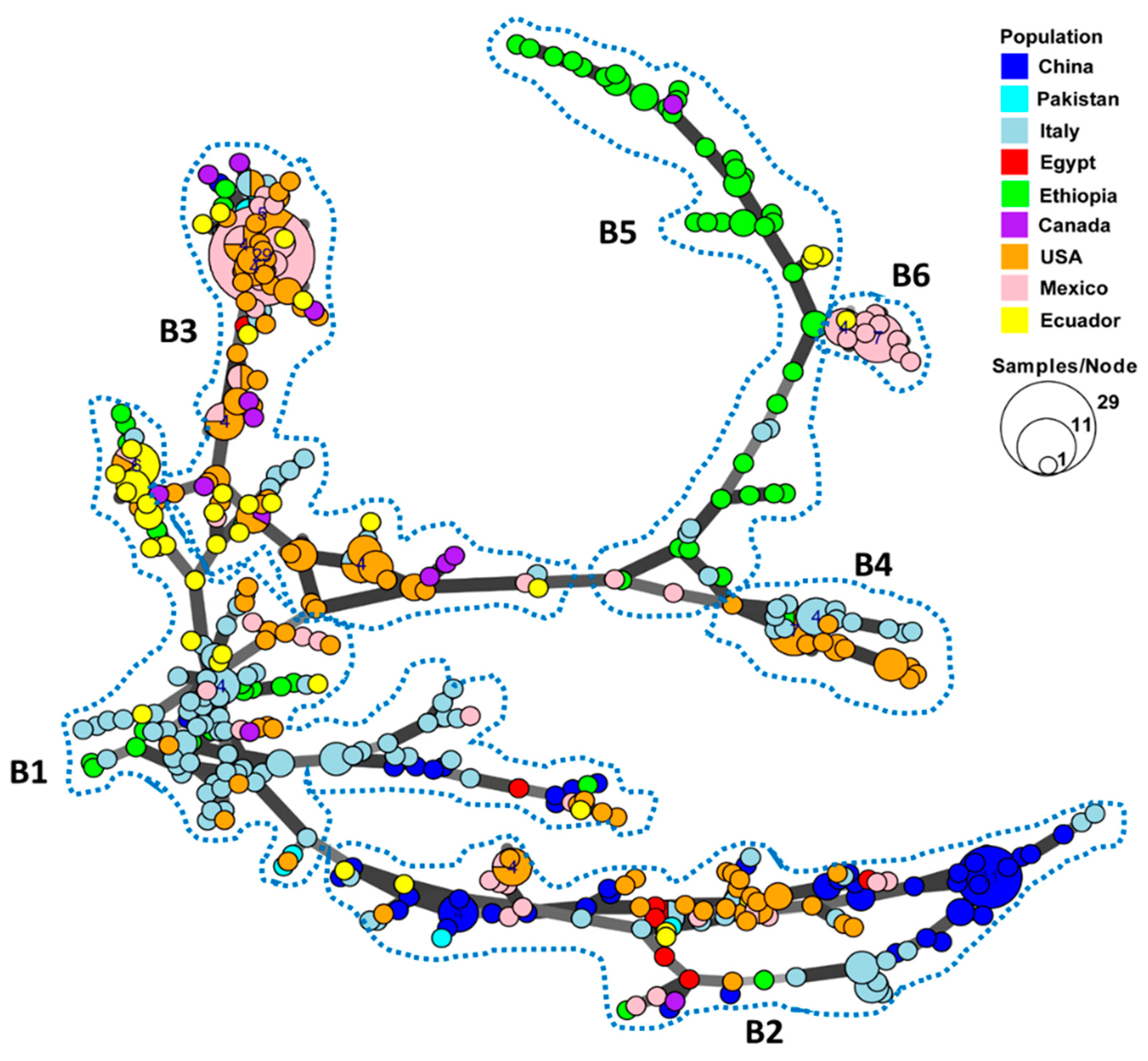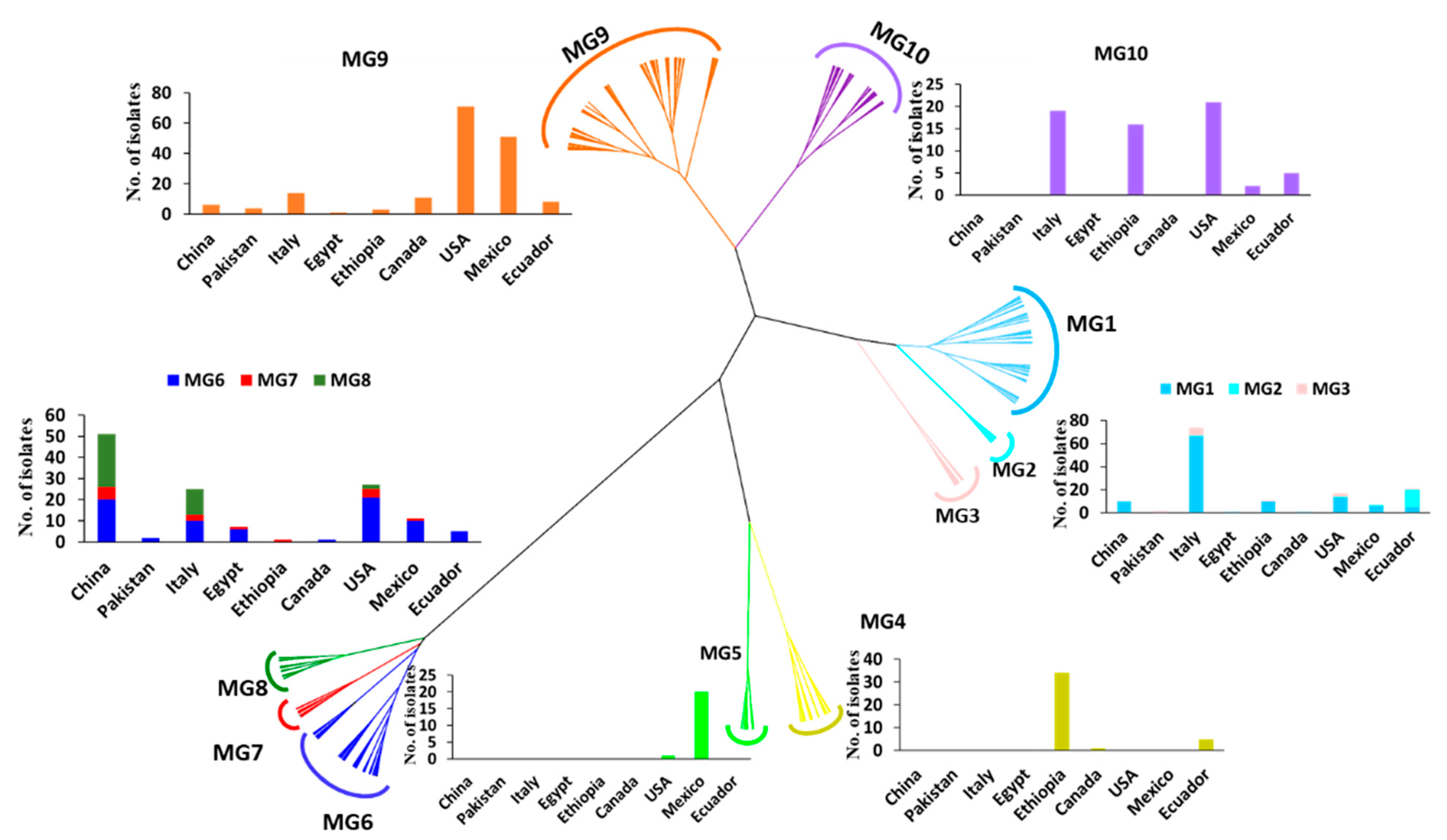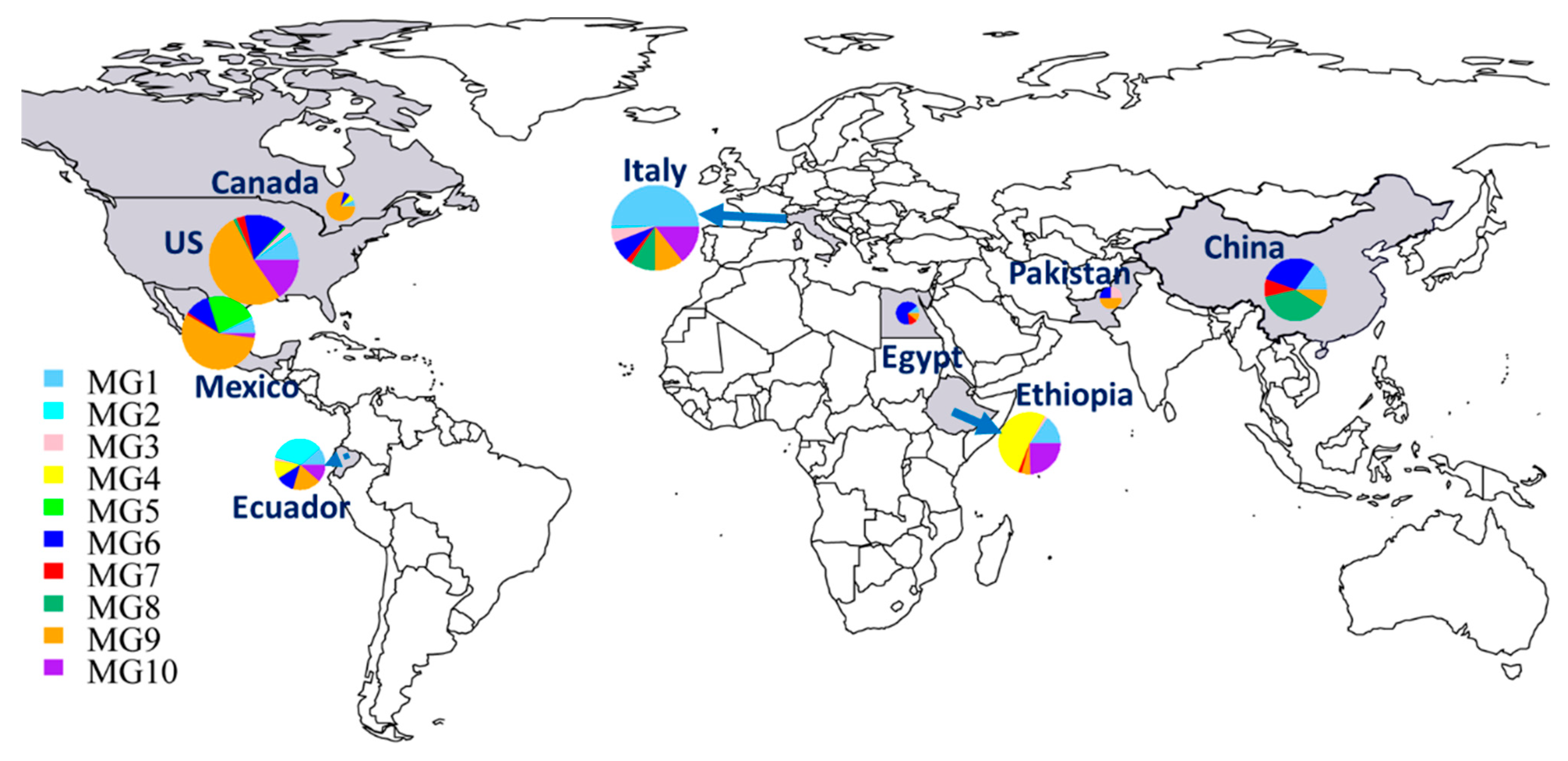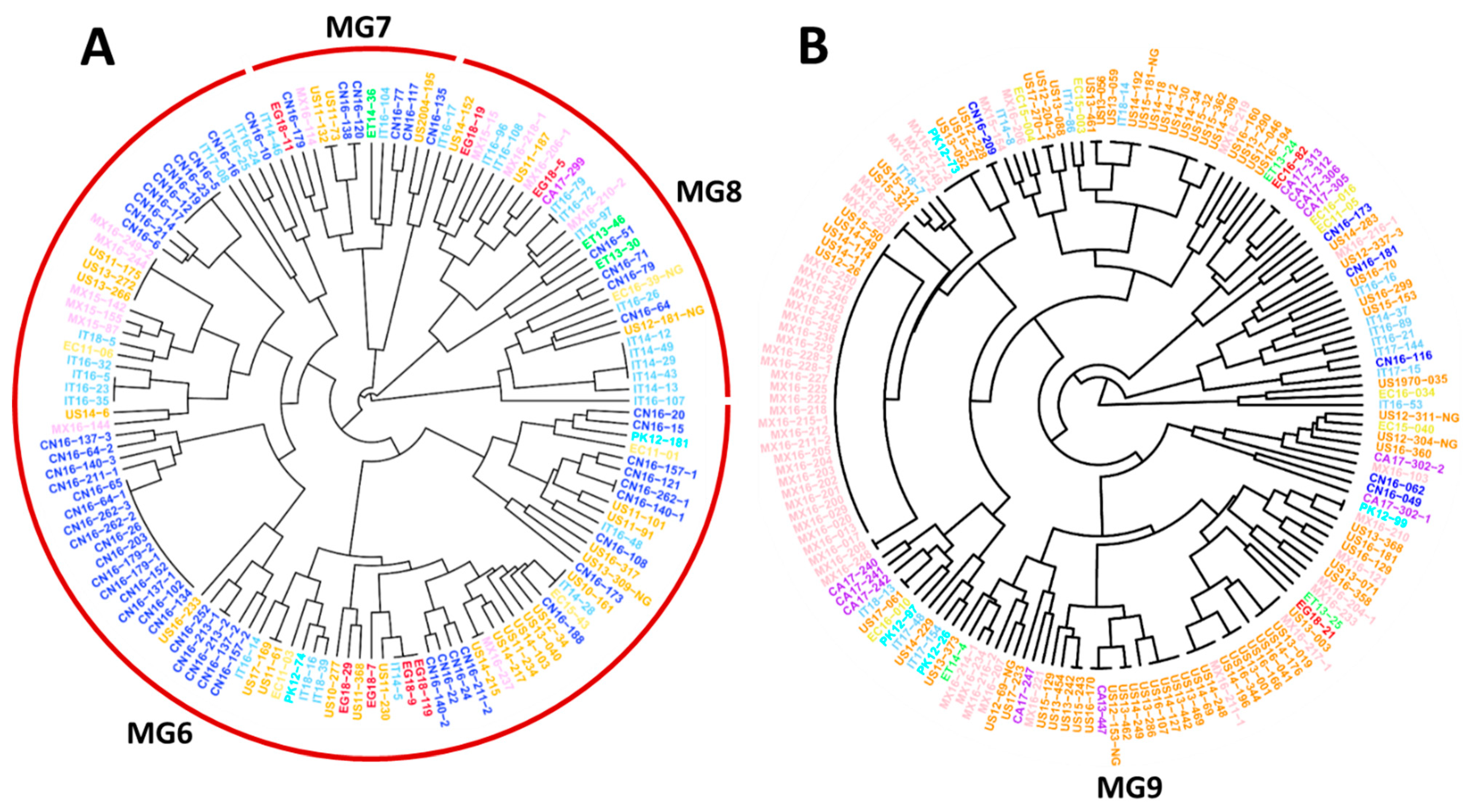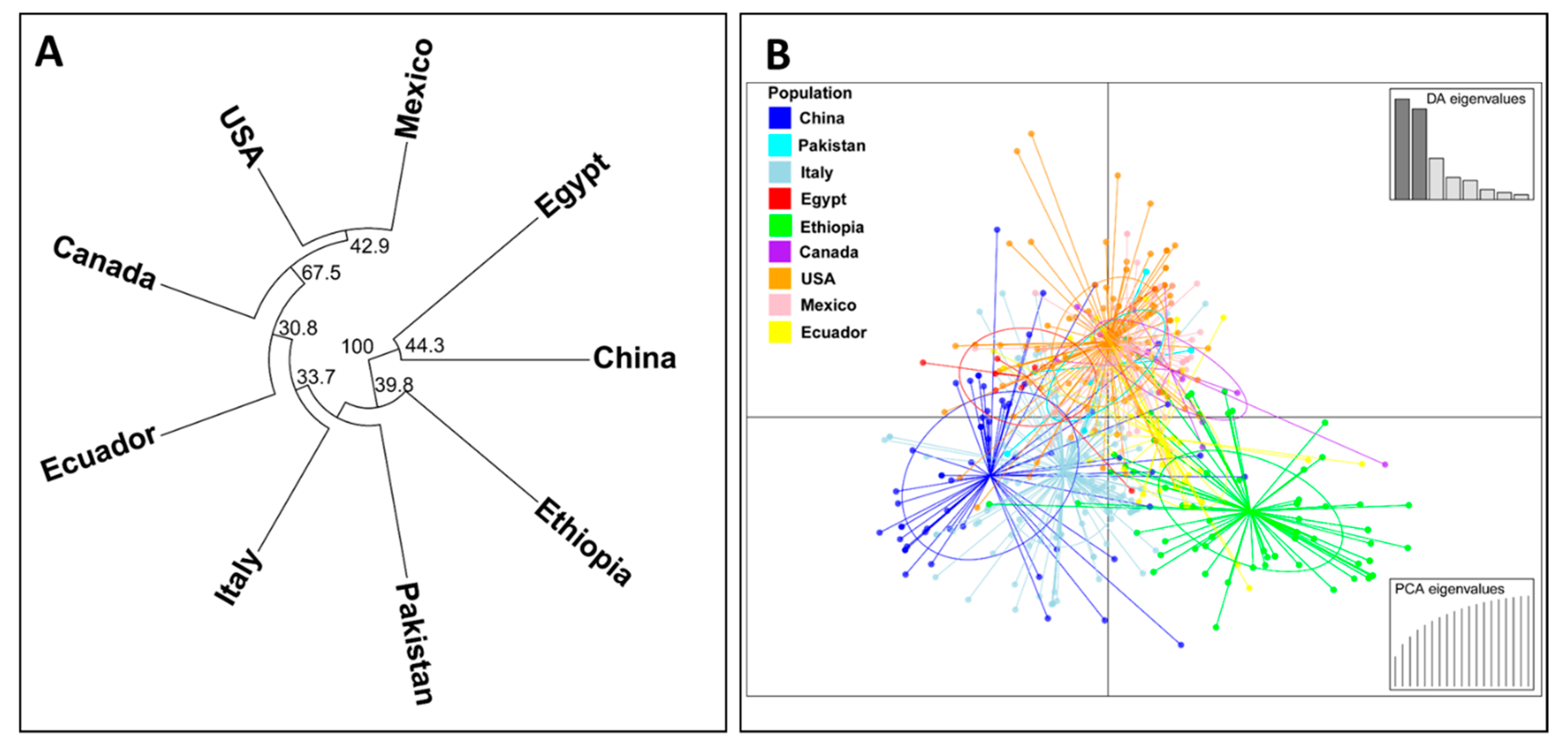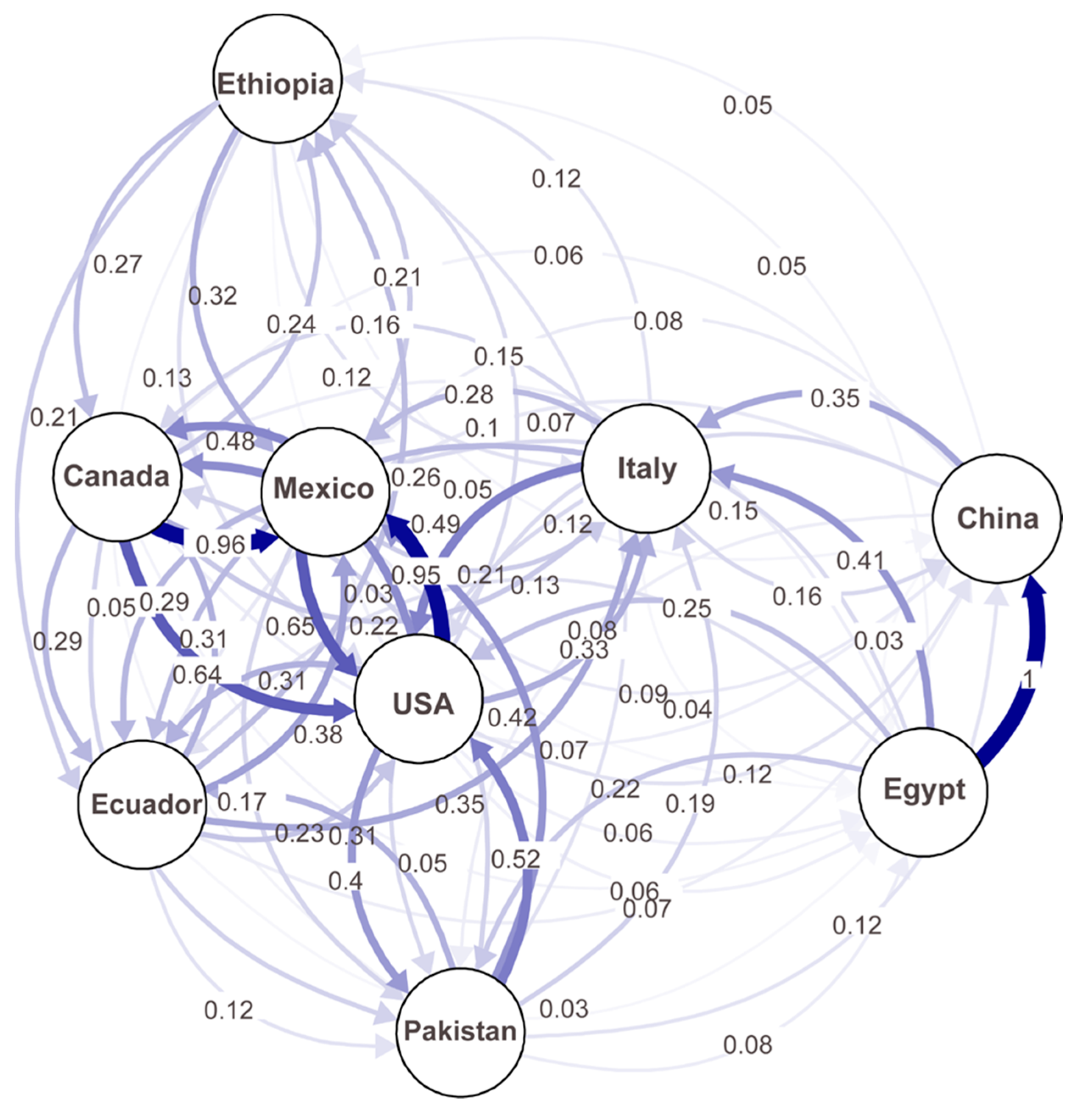1. Introduction
Stripe rust (yellow rust) caused by
Puccinia striiformis Westend. f. sp.
tritici Erikss. (
Pst) is a destructive disease across major wheat growing regions of the world [
1,
2,
3,
4,
5]. Yield losses caused by stripe rust vary greatly depending upon the susceptibility of cultivars, the time point of initial infection, the rate of disease development, and the duration of the disease, but can reach up to 100% if highly susceptible cultivars are grown under extremely favorable weather conditions for stripe rust development [
4,
6,
7,
8]. Due to the capacity for rapid changes in virulent races to circumvent resistance in wheat cultivars and genotypes adapting to different environments, as well as the long-distance dissemination of
Pst urediniospores via wind dispersal or human activities, stripe rust is an increasing problem threatening global wheat production [
4,
6,
9,
10,
11,
12,
13,
14,
15].
In the past two decades, a series of severe epidemics caused by stripe rust were reported in large-scale regions, including East Asia, Central and West Asia, East and North Africa, Europe, western Australia, and North and South America [
4,
5,
6,
7,
16,
17,
18,
19,
20]. Since 2000, new races, as well as aggressive and high temperature-adapted strains, have spread the major
Pst populations worldwide and caused severe damage in terms of yield loss and cost of fungicide applications in many countries. For example, severe epidemics occurred throughout the U.S. in 2000, 2001, 2003, 2005, 2010, 2011, 2015, and 2016 [
4,
5,
17], and in Australia in 2003–2006 [
5,
21]. In 2010, prevalent stripe rust caused economic losses in East Africa [
20], Central and West Asia [
5,
19,
20], and North America [
5,
6,
7,
22,
23]. For example, a devastating stripe rust epidemic occurred on more than 600,000 ha of wheat in Ethiopia, which led to a cost of more than USD 3.2 million in the application of fungicides [
20]; similarly in the U.S., wheat stripe rust caused the most widespread epidemic throughout the whole country in recorded history in 2010, and the extremely severe epidemic in the Pacific Northwest in 2011, which resulted in large-scale applications of foliar fungicides [
5,
6,
7]. Since 2011, the invasive races of
Pst, “Warrior” and “Kranich” largely destroyed the pre-existing NW European populations. Moreover, the “Kranich” race has been demonstrated to have a high sexual reproduction capacity under suitable conditions, leading to potential threats to wheat production worldwide [
14,
24,
25].
To track the migration routes, determine the origin, and detect changes in genetic groups, several studies have been performed on
Pst at relatively large geographic scales using different molecular markers and virulence data. Some studies have suggested that the Himalayan region or the whole Mediterranean to Asia region may be the putative center of origin of
Pst, because of its high genotypic diversity, high ability for sexual reproduction, and the strong differentiation from other populations [
1,
13,
26]. The Asian populations, including those in China, Nepal, and Pakistan, have been indicated as the possible sources of the emergence of new, virulent, and aggressive strains due to the high level of recombination, diversity, and ability for sexual reproduction, the latter of which has been reported in China in several studies [
27,
28,
29,
30,
31]. Other studies have also tried to track the migration of
Pst populations and the worldwide distribution of different genetic linkages [
15,
26,
32,
33]. However, recent molecular studies on the characterization of international
Pst collections have been conducted mainly on isolates collected before 2010 [
13,
33], indicating that more recent populations must be characterized to determine whether the international
Pst population has undergone any major genetic changes since 2010.
In our group, stripe rust samples are routinely collected and received from throughout the U.S., and the
Pst isolates are characterized for virulence using a set of wheat differentials and for genotypes using simple sequence repeat (SSR) and other markers [
4,
22,
23,
34,
35,
36,
37,
38,
39,
40,
41,
42,
43]. These studies identified a large number of virulence races and multi-locus genotypes (MLGs) in the
Pst populations, as well as clonal production, relatively high diversities in some epidemiological regions and on grass hosts, differentiation and migration among different regions, and long-term dynamics for inferring evolutionary mechanisms. In addition, the roles of sexual reproduction, somatic reproduction, and mutation in
Pst variation were studied by developing sexual, somatic recombinant, and mutation populations under controlled conditions, characterized by both virulence testing and molecular markers [
41,
42,
43,
44,
45,
46,
47,
48]. Our laboratory has received stripe rust samples from other countries and characterized them through virulence testing and using molecular markers [
26,
49,
50,
51,
52]. Previous studies characterized
Pst isolates collected from 16 countries in 2006–2010 through virulence testing [
50] using co-dominant SSR markers [
26]. These studies identified large numbers of races [
50] and genotypes, and revealed overall high diversity and migrations among different countries [
26]. Since 2010, we have received stripe rust samples from eight countries (Canada, China, Ecuador, Egypt, Ethiopia, Italy, Mexico, and Pakistan), in addition to the U.S. collections. The virulence data from the collections from Ethiopia in 2013 and 2014 [
51], and those from the collections from other countries collected from 2013 to 2020, except the data from the U.S. collections from 2013 to 2020, have recently been published [
52], but the molecular characterization of the foreign collections has not been published. Based on the virulence data of these collections, it was hypothesized that
Pst migrations have occurred among different countries and continents in the recent years. The present study was conducted to test the hypothesis via the molecular characterization of the collections.
The specific objectives of this study were to (1) characterize the international collections of
Pst since 2010 using SSR markers and identify molecular groups, (2) determine and compare the levels of genetic diversities, heterozygosity, and differentiation among different molecular groups and countries, and (3) track migrations among
Pst populations among different countries. Using the molecular data, we also inferred reproduction mode and the correlation between the molecular data and previously published virulence data [
51,
52]. The results should provide a better understanding of stripe rust epidemiology and distribution, and the migration of the pathogen populations, as well as mechanisms of pathogen evolution.
3. Discussion
The stripe rust pathogen is distributed in the wheat-growing countries throughout the world, and the fungus evolves and disseminates rapidly from one country to another [
9,
10,
11,
13,
14,
15,
21,
26,
32,
33]. The present study successfully tested the hypothesis that
Pst migrates among countries and continents, which was proposed based on the virulence data of the collections from different countries in a recent study [
52]. Our study offers clear evidence supporting
Pst migration around the global. In addition, our study found great diversities within country-wise populations and significant differences among the country-wise populations and molecular groups. The results of the present study expand our understanding of the mechanisms of the pathogen’s evolution.
In this study, we identified 433 MLGs, including 333 previously undescribed MLGs, from 567
Pst isolates collected from nine countries using 14 SSR markers. The 14 markers were adequate to characterize the
Pst collection, as the marker sufficiency test indicated that 99.5% of the 433 MLGs could be differentiated with only 13 markers (data not shown), which is consistent with our previous study of U.S. collections with the same 14 SSR markers [
43]. The 433 MLGs were clustered into 10 MGs, and these MGs had different frequencies and distributions in different countries, and they differed in diversity, heterozygosity, and correlation with virulence phenotypes. Similarly, the country-wise populations also had different levels of diversity and differentiation, and differed in heterozygosity and correlation with virulence phenotypes. However, we detected identical and closely related MLGs in several MGs from different countries. These results indicate the rapid dissemination of specific genetic populations across different continents. Moreover, the analyses of reproduction mode indicate that the overall and country-wise
Pst populations were generally clonal, but recombination was detected within several MGs. Therefore, this study provides insights for understanding the global diversity, distribution, differentiation, migration, and reproduction of the
Pst populations.
The geographic distribution and genetic relatedness of the MLGs in different countries were analyzed by the minimum spanning networks by utilizing a stepwise mutation model for the 14 SSR loci. Even though most of the MLGs were private and more closely related within each country, some MLGs from different countries were also interrelated. MLGs from geographically close countries, such as Ecuador, Mexico, and the U.S., and geographically distant countries, such as China, Italy, and the U.S., were both found to be identical or very closely related, indicating migrations or incursions from country to country, which supports the previous reports of the international migration of
Pst in recent decades [
9,
13,
14,
26,
32,
50,
56].
The 433 MLGs were clustered into ten MGs, of which some were present in all countries, also indicating Pst migration among different countries. Among the ten MGs, MG1, MG6, and MG9 had more isolates and were more diverse and widespread. These MGs consisted of isolates from eight or all nine countries. Although each of the MGs was detected in at least two countries, they appeared to have preferred countries. MG1 and MG3 had the highest numbers of isolates from Italy. MG2 had the highest frequency in Ecuador, MG4 in Ethiopia, MG5 in Mexico, and MG8 in China. MG6 had the highest number of isolates from the U.S., immediately followed by China. MG7 had the highest number of isolates from China followed by the U.S. and Italy. The highest number of isolates of MG9 was from the U.S., followed by Mexico. The U.S. contributed the highest number of isolates to MG10, followed by Italy and Ethiopia. The ten MGs had different levels of relatedness. MG1, MG2, and MG3 were more closely related to each other, and so were MG6, MG7, and MG8. The differences in predominant MGs in different countries may be due to the different foundation populations existing and evolving independently, plus the shared genotypes migrating among countries in recent years.
In a previous study of only U.S. isolates using the same 14 SSR markers, three major groups (MGs) with 10 subgroups (sub-MGs) were identified [
43]. The relationships of the 10 MGs identified in the present study were similar to those of the previously identified sub-MGs. For example, 82% of the U.S. isolates in MG6, MG7, and MG8 in the present study were from the previously identified sub-MGs of MG3, which is a new MG that has only been detected since 2000, and mainly since 2010 in the U.S. [
43]. In the present study, MG9 consisted of isolates mostly from the U.S. and Mexico and also contained isolates from all other countries. MG6–MG9 may be related to the aggressive strains widely spreading in the world, as reported in previous studies [
11,
13,
14,
33,
57]. Some small MGs were genetically distant from other MGs and specific to one or a few countries, such as MG4 in Ethiopia and MG5 in Mexico, indicating the possibility of new emergence or incursions. The other small MGs had close relationships with the large MGs, but were separated into different groups. For example, the second smallest group, MG2, was closely related to the second largest group, MG1. As MG2 was mostly from Ecuador and MG1 widespread in eight countries including Ecuador, MG2 was likely evolved from MG1, and became more adapted to the environment and wheat cultivars in Ecuador. Mostly from China and Italy, MG8 was closely related to MG6, which was detected in all countries except Ethiopia. It is likely that MG8 has recently evolved from MG6, as a larger and more diverse group takes longer to develop than a small and less diverse group. Because
Pst is capable of long-distance spreading by wind or occasional human activities [
9,
13], these initially small and distinct groups may undergo future wide distribution. Therefore, even though the genetic groups are unique to certain countries, they need to be continually monitored for possible dispersal to other countries or continents.
Despite its capacity for long-distance migration, the global
Pst population may be very complex due to a combination of other factors, such as different cropping systems, variable climate conditions, and different geographic features [
9]. For example, the highest F
ST value of 0.540 was found between China and East Africa using the Stubbs Collections from various countries mainly before the 1990s, indicating a strong population subdivision [
1,
13]. In our previous study, we found low to moderate levels of differentiation, with the highest F
ST value of 0.15 between East Asia and South America in the worldwide collections from 2006–2010 [
26]. In the present study, the collections from nine countries were more recent (2010–2018), and the highest F
ST value (0.263) was also between China and East Africa (Ethiopia), which was similar to the result of the study by Ali et al. [
13]. However, even though most of the pairwise country comparisons for differentiation as measured by F
ST values were significant (excluding Egypt and Pakistan, because of small numbers of isolates), the population differentiations were at low to moderate levels, further confirming the international migrations of
Pst, especially in the more recent years since 2010. We found that, overall, genetic variation mostly existed among isolates (78%), with only 10% within countries and 12% among countries. These values are comparable to the 81% among isolates and 13% among countries in our previous study of the international
Pst collections of 2006–2010 [
26]. This indicates a trend of more rapid globalization in
Pst populations. With the global spreading of the new aggressive strains, including the sudden appearance of MGs in the U.S. in 2010 and 2011 [
43], there have been widespread epidemics of stripe rust, causing huge economic losses in many countries in Central and West Asia, East Africa, and North America in the last decade [
5,
20,
22,
23]. Therefore, monitoring
Pst genotypes is continually needed.
High levels of genotypic diversity were observed in Italy, China, the U.S., and Ethiopia. These results are consistent with a previous study that also reported high levels of diversity in Asia and the Mediterranean area [
26]. This is quite different from the study of Ali et al. (2014), who reported low levels of diversity in the Mediterranean area and North America [
13]. In the present study, the highest level of genotypic diversity (4.69 for H and 96.8 for G) was in the Italian population. Italy is part of the Mediterranean region, which was considered a center of origin for
P. striiformis by Stubbs (1985) [
1]. In a recent study analyzing weather conditions for suitability to
Pst infection, Italy was found among the countries with high risk to stripe rust [
58]. The difference could be due to the sizes and regions of
Pst samples. The North American samples analyzed by Ali et al. (2014) were from southcentral states [
13], where
Pst has a much lower diversity than in the western U.S. [
22,
23,
43,
59,
60]. In general,
Pst populations should show high diversity in regions with weather conditions and cropping systems favorable to their survival, infection, and reproduction. All above genetic studies reported that the Asian
Pst population is relatively highly diverse compared to those of some other regions, and this high diversity may be partially related to possible sexual reproduction in this continent [
13,
27,
28,
29,
30,
31,
61]. In 2014, the Himalayan region was proposed as a
Pst point of origin [
13]. In agreement with our previous study, the whole Mediterranean to Asian region could be the main center of origin for the stripe rust fungus. This modified hypothesis is related to the long history of cereal cultivation and stripe rust epidemics in this big geographic region [
1,
3].
As
Pst is a dikaryotic fungus, the heterozygosity of isolates makes a major contribution to the overall diversity. Ali et al. (2014) studied the heterozygosity of
Pst populations in different countries and reported heterozygosity values of 0.28 in China and 0.35 in Pakistan [
13]. In the present study, we observed high levels of heterozygosity in Canada (49%), the U.S. (48%), Italy (47%), and Mexico (45%), with the lowest levels in China (21%) and Egypt (18%). The heterozygosity values of China and Pakistan were comparable with those reported by Ali et al. (2014) [
13], and the values of Pakistan, Mexico, and the U.S. were consistent with our previous study [
43]. However, the heterozygosity value for China in the present study was much lower than that in our previous study (47%) [
43]. This difference could be due to the different regions of the collections. In the previous study, the Chinese isolates were from the northwestern region, while in the present study, the samples were from only one province (Yunnan) in the southwestern region. The
Pst populations in these two regions of China are quite different [
30,
62]. In addition to the different heterozygosity levels among the country-wise populations, differences in heterozygosity were also detected among the MGs, with the highest heterozygous allele frequencies in MG9 (57%) and MG10 (56%) and the lowest in MG5 and MG6 (both 14%). The heterozygous allele frequencies were significantly correlated to the numbers of isolates of MGs (r = 0.692,
P = 0.027), which may support the hypothesis that heterozygous isolates may have advantages in pathogen evolution because of the heterosis effect, which may be involved in adaptation to different environments and host cultivars with different resistance genes [
26,
43].
Most previous studies reported the clonal reproduction of
Pst populations in many parts of the world [
26,
29,
36,
37,
38,
43,
57,
63]. Some studies on population genetics have suggested the sexual recombination of
Pst in China and the Himalayan region [
13,
30,
31,
61], and the natural infection of
Pst in barberry for sexual reproduction was reported at low frequencies in China [
25,
27,
28,
29]. In the present study, clonal reproduction was indicated for each individual country and also for the overall population. However, when the isolates in the 10 MGs were analyzed separately for the standardized index of association (rbarD), 5 MGs (MG2, MG3, MG6, MG7, and MG8) were found to have recombination at the
P = 0.01 level, and at the
P = 0.05 level, 3 MGs (MG2, MG3, and MG8) were still considered to have possible recombination. Based on the lowest rbarD value (0.006) and the highest
P value (0.309), MG8 is most likely to be produced by sexual recombination. In fact, most MG8 isolates were from China and Italy. China has been shown to have sexual reproduction [
25,
27,
28,
29], and Italy has been reported to be at a high potential risk of
Pst infection on barberry [
58]. Thus, this study provides evidence for
Pst sexual recombination in some countries, especially China. Not all possibilities of recombination are through sexual reproduction, and some of them may be results of somatic recombination. Somatic recombination has been demonstrated for
Pst under controlled conditions [
44], and has been reported to produce virulent races in
Puccinia graminis f. sp.
tritici, the wheat stem rust pathogen [
64,
65]. Nevertheless, among all possible mechanisms, mutation is the most important for
Pst evolution, which is illustrated by the minimum span of the network for stepwise mutations to produce the majority of MLGs in the present study (
Figure 1), as is consistent with our previous studies [
26,
43].
The overall correlation coefficient value (0.235) between the molecular genotype data and the previously published virulence data [
51,
52] was low, but significant. This value is lower than the 0.41 value reported for the international collections from 2006 to 2010 [
26]. The difference could be due to the collections being from different countries in the two studies, as different country populations had different coefficient values in the present study. The U.S. and Ethiopian populations had the highest correlations, while the Ecuadorian population had the lowest correlation. Similarly, the different MGs had different coefficient values, with MG2 having the highest (0.308) and MG4 the lowest (0.069). The correlations in five MGs were significant, but they were insignificant in the other five MGs. The differences in correlation may indicate different deployments of specific resistance genes in different countries, and some MGs have been under stronger wheat cultivar selection pressure than others. Because the overall correlation is not very high, neither virulence nor molecular tests can provide a complete picture of the pathogen population. Thus, it is important to continually characterize
Pst populations using both virulence testing and molecular markers.
